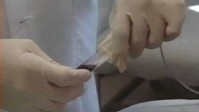Doctors told Thomas DeLorenzo he would have lived only two more days had he not come into the emergency room when he did in January 2001. He was dying of AIDS, they said, and his future was bleak because he had waited so long to get treated.
He was in denial for years after his partner died of AIDS in 1995. But after finally getting diagnosed six years later, he "did whatever the doctors said. Whatever it took," DeLorenzo, 49, of Los Angeles said.
"I remember the first day I took the medication," said DeLorenzo, who is now in law school. "It's this big moment that you say, 'Oh f---, here I am.' Reality just hits you in the face."
That was in 2001. After several trials and errors with drug cocktails, he has found a a stable treatment regimen that includes about 17 pills each day to combat and suppress the HIV, while also curbing side effects of the drugs.
And now, a new once-daily "Quad" pill might be added to the arsenal of effective HIV treatments in the near future, according to a new study published in the Lancet.
For adults starting antiretroviral treatment, the U.S. Department Health and Human Services recommends the standard treatment for HIV-positive patients, four different drugs, which involved several pills multiple times a day. But the results of the quad drug research add to other combination agents available to patients today.
Digital Vision/Getty Images

Researchers from Harvard Medical School randomly assigned 700 North American patients on two different single-pill regiments, either the new Quad or Atripla, a drug that has become the standard treatment, approved by the FDA in 2006.
After nearly one year of treatment, 88 percent of patients on the Quad experienced a suppression of the virus, compared with 84 percent of the patients on Atripla, the study showed.
Both drugs were also proven to be safe, with only 3.7 percent of the study participants stopping the Quad and 5.1 percent stopping the Atripla.
As more innovative interventions have been created to combat HIV/AIDS, more patients have been able to live fuller, longer lives with the disease. Still, more than 1.1 million Americans were estimated to be living with HIV in 2008, according to the Centers for Disease Control.
"Response to the Quad was favorable across a wide range of patients, including those with high HIV viral loads who are sometimes difficult to treat," Dr. Paul Sax, clinical director of infectious disease at Harvard Medical School, told ABCNews.com.
"The side effect profile differed, in that Quad caused fewer rashes and central nervous system side effects than Atripla, but more nausea," Sax said. "Overall, both treatments were very well tolerated. These results suggest that Quad will be an important new option for HIV treatment if it is approved."
An FDA advisory committee met in May to review data on the Quad and voted in favor of its approval. A final decision by the FDA is expected this summer, Sax said.
But Dr. Mark Kline, a pediatric AIDS expert at Baylor College of Medicine in Houston, said the study only shows a modest advance in a long lineage of clinical trials that has led to a variety of simpler, easier, better tolerated and more effective regimens for initial treatment of HIV/AIDS.
"The real unmet need in HIV/AIDS is for simple treatment regimens safe and effective for HIV-infected patients who have failed other therapies because of viral resistance," Kline said.




No comments:
Post a Comment